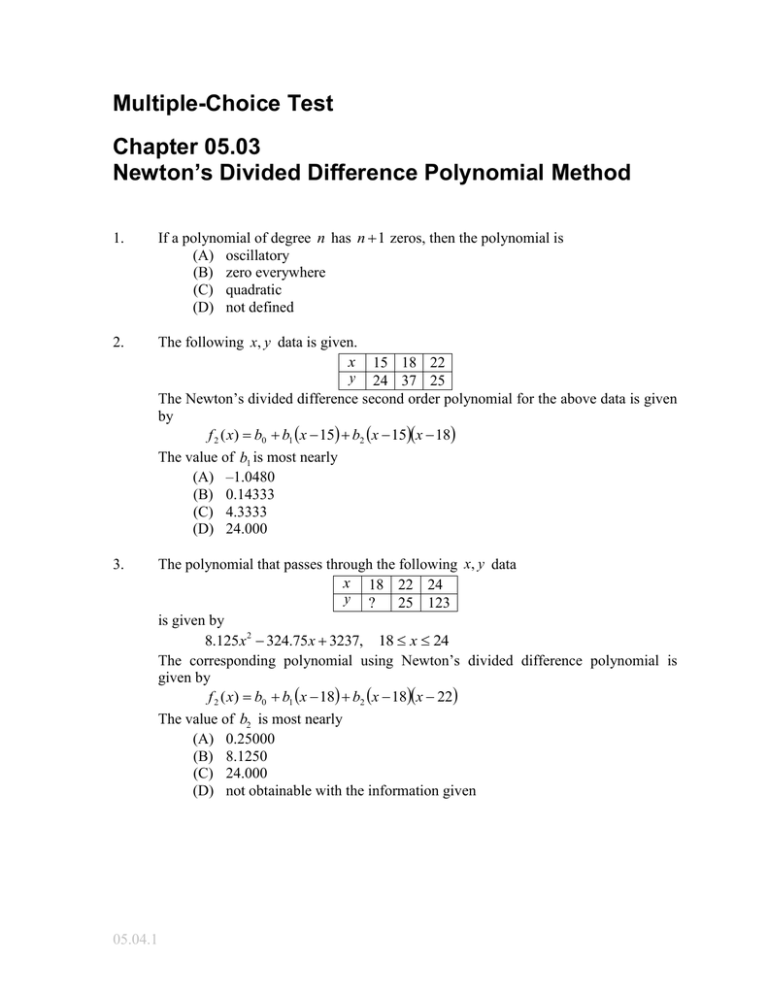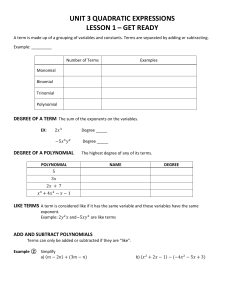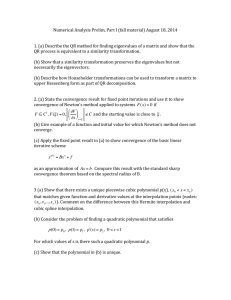Multiple-Choice Test Chapter 05.03 Newton’s Divided Difference Polynomial Method
advertisement

Multiple-Choice Test Chapter 05.03 Newton’s Divided Difference Polynomial Method 1. If a polynomial of degree n has n 1 zeros, then the polynomial is (A) oscillatory (B) zero everywhere (C) quadratic (D) not defined 2. The following x, y data is given. x 15 18 22 y 24 37 25 The Newton’s divided difference second order polynomial for the above data is given by f 2 ( x) b0 b1 x 15 b2 x 15x 18 The value of b1 is most nearly (A) –1.0480 (B) 0.14333 (C) 4.3333 (D) 24.000 3. The polynomial that passes through the following x, y data x 18 22 24 y ? 25 123 is given by 8.125x 2 324.75x 3237, 18 x 24 The corresponding polynomial using Newton’s divided difference polynomial is given by f 2 ( x) b0 b1 x 18 b2 x 18x 22 The value of b2 is most nearly (A) 0.25000 (B) 8.1250 (C) 24.000 (D) not obtainable with the information given 05.04.1 05.04.2 4. Chapter 05.03 Velocity vs. time data for a body is approximated by a second order Newton’s divided difference polynomial as vt b0 39.622t 20 0.5540t 20t 15, 10 t 20 The acceleration in m/s 2 at t 15 is (A) 0.5540 (B) 39.622 (C) 36.852 (D) not obtainable with the given information 5. The path that a robot is following on a x y plane is found by interpolating the following four data points as x 2 4.5 5.5 7 y 7.5 7.5 6 5 3 2 yx 0.1524 x 2.257 x 9.605x 3.900 The length of the path from x 2 to x 7 is 7.5 7.52 4.5 22 6 7.52 5.5 4.52 5 62 7 5.52 (A) 7 (B) 1 (0.1524 x 3 2.257 x 2 9.605 x 3.900) 2 dx 2 7 (C) 1 (0.4572 x 2 4.514 x 9.605) 2 dx 2 7 (D) (0.1524 x 3 2.257 x 2 9.605 x 3.900)dx 2 6. The following data of the velocity of a body is given as a function of time. Time (s) 0 15 18 22 24 Velocity (m/s) 22 24 37 25 123 If you were going to use quadratic interpolation to find the value of the velocity at t 14.9 seconds, the three data points of time you would choose for interpolation are (A) 0, 15, 18 (B) 15, 18, 22 (C) 0, 15, 22 (D) 0, 18, 24 For a complete solution, refer to the links at the end of the book. 05.03.2





